-
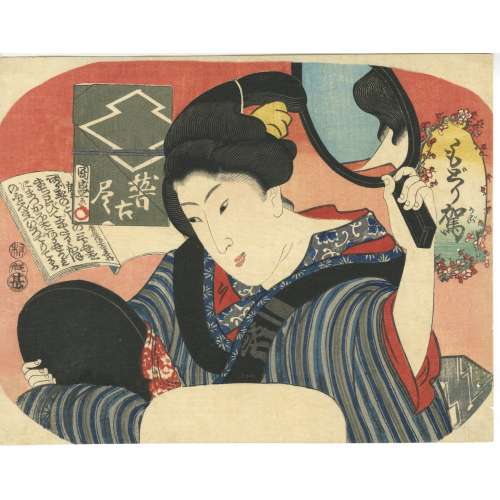 Title: Modori Kago [戻駕] (Returning palanquin). The dance-drama Modori Kago Iro ni Aikata [戻駕色相肩] premiered in the 11th lunar month of 1788 at the Nakamuraza [中村座], within Sakurada Jisuke I's kaomise [顔見世] (faceshowing) program Tôzumô Hana no Edogata [唐相撲花江戸方]", which celebrated the homecoming to Edo, after two years' absence, of Nakamura Nakazō I, and was intended to show off his particular talents in the role of Jirosaku (in reality Ishikawa Goemon [石川 五右衛門]) [kabuki21]. The symbol on a green book cover is the informal crest of tokiwazu-bushi [常磐津節] shaped like a water chestnut (Eleocharis dulcis) lozenge. Artist signature 国盛画 (Kunimori ga) with red toshidama. According to Samuel L. Leiter’s Kabuki Encyclopedia (1979), p. 243: The palanquin bearers Nanpa no Jirosaku and Azuma no Yōshirō, who are bearing a palanquin with a courtesan's young handmaiden in it, stop to rest at Kyoto's Murasakino, and each dances his regional dance. Then they call the girl, who does a dance showing the visitors to the famous pleasure quarters, Yoshiwara and Shimabara. The two men recognize each other as Ishikawa Goemon and Masashiba Hisayoshi, sworn enemies, and engage in a fight. This number is the only remaining section of an annual "faceshowing” (kaomize) work with a plot based on the medieval chronicle called the Toikōki. The full-length piece was called Kara Sumō Hanaeda no Kata. It is one of the most famous tokiwazu pieces and preserves the old-style Kabuki flavour. Nakamura Nakazō I played Jirosaku and Matsumoto Kōshirō IV was Yoshiro in the first production. The handmaiden was Matsumoto Komesaburō (probably Matsumoto Komasaburō I, an unknown actor [SV]). According to Egenolf Gallery: This work was first performed in 1788 at the Edo Nakamura-za as the season’s first performance and featured Nakamura Nakazō, who returned to Edo after three years in Osaka. It was a dance with tokiwazu chanting and was designed for him to play the lead role. In the piece, two palanquin carriers, one from Osaka, another from Edo, and a passenger – a kamuro, (a young geisha-in-training) exchange stories about the pleasure quarters of Shimabara and Yoshiwara. The text of the chanting book is open next to her, carrying the title “Collection of Practicing” [稽古尽くし], on which the green bundle cover carries the crest of Tokiwazu School, matsu-kawa-bishi, diamond variety of pine bark and the artist’s signature. Tokiwazu is a type of jōruri, narrative music, and accompanies dancing on the kabuki stage. Ref.: Christie's 27 Mar 2006. Publisher: Maruya Jinpachi, seal Marujin (Marks: 12-029 | 294e) Single nanushi censor seal: Mura (Murata Sahei, 1842-46). Provenance: Circular seal of the collector Huguette Bérès to verso. Contributors: Utagawa Kunimori [歌川国盛] (Japanese, fl. c. 1818 – 1943) – artist. Maruya Jinpachi [丸屋甚八] (Japanese, fl. 1770 – 1842) – publisher. Other mentioned: Nakamura Nakazō I [中村仲蔵] (Japanese, 1736 – 1790); other names: Nakayama Kojūrō VI, Nakamura Ichijūrō, Nakayama Manzō – actor. Matsumoto Kōshirō IV [松本幸四郎] (Japanese, 1737 – 1802); other names: Omegawa Kyōjūrō; Ichikawa Komazō II, Ichikawa Somegorô I, Ichikawa Takejūrō ; Segawa Kinji; Segawa Kingo – actor. Sakurada Jisuke I [桜田治助] (Japanese, 1734 – 1806) – dramatist.
Title: Modori Kago [戻駕] (Returning palanquin). The dance-drama Modori Kago Iro ni Aikata [戻駕色相肩] premiered in the 11th lunar month of 1788 at the Nakamuraza [中村座], within Sakurada Jisuke I's kaomise [顔見世] (faceshowing) program Tôzumô Hana no Edogata [唐相撲花江戸方]", which celebrated the homecoming to Edo, after two years' absence, of Nakamura Nakazō I, and was intended to show off his particular talents in the role of Jirosaku (in reality Ishikawa Goemon [石川 五右衛門]) [kabuki21]. The symbol on a green book cover is the informal crest of tokiwazu-bushi [常磐津節] shaped like a water chestnut (Eleocharis dulcis) lozenge. Artist signature 国盛画 (Kunimori ga) with red toshidama. According to Samuel L. Leiter’s Kabuki Encyclopedia (1979), p. 243: The palanquin bearers Nanpa no Jirosaku and Azuma no Yōshirō, who are bearing a palanquin with a courtesan's young handmaiden in it, stop to rest at Kyoto's Murasakino, and each dances his regional dance. Then they call the girl, who does a dance showing the visitors to the famous pleasure quarters, Yoshiwara and Shimabara. The two men recognize each other as Ishikawa Goemon and Masashiba Hisayoshi, sworn enemies, and engage in a fight. This number is the only remaining section of an annual "faceshowing” (kaomize) work with a plot based on the medieval chronicle called the Toikōki. The full-length piece was called Kara Sumō Hanaeda no Kata. It is one of the most famous tokiwazu pieces and preserves the old-style Kabuki flavour. Nakamura Nakazō I played Jirosaku and Matsumoto Kōshirō IV was Yoshiro in the first production. The handmaiden was Matsumoto Komesaburō (probably Matsumoto Komasaburō I, an unknown actor [SV]). According to Egenolf Gallery: This work was first performed in 1788 at the Edo Nakamura-za as the season’s first performance and featured Nakamura Nakazō, who returned to Edo after three years in Osaka. It was a dance with tokiwazu chanting and was designed for him to play the lead role. In the piece, two palanquin carriers, one from Osaka, another from Edo, and a passenger – a kamuro, (a young geisha-in-training) exchange stories about the pleasure quarters of Shimabara and Yoshiwara. The text of the chanting book is open next to her, carrying the title “Collection of Practicing” [稽古尽くし], on which the green bundle cover carries the crest of Tokiwazu School, matsu-kawa-bishi, diamond variety of pine bark and the artist’s signature. Tokiwazu is a type of jōruri, narrative music, and accompanies dancing on the kabuki stage. Ref.: Christie's 27 Mar 2006. Publisher: Maruya Jinpachi, seal Marujin (Marks: 12-029 | 294e) Single nanushi censor seal: Mura (Murata Sahei, 1842-46). Provenance: Circular seal of the collector Huguette Bérès to verso. Contributors: Utagawa Kunimori [歌川国盛] (Japanese, fl. c. 1818 – 1943) – artist. Maruya Jinpachi [丸屋甚八] (Japanese, fl. 1770 – 1842) – publisher. Other mentioned: Nakamura Nakazō I [中村仲蔵] (Japanese, 1736 – 1790); other names: Nakayama Kojūrō VI, Nakamura Ichijūrō, Nakayama Manzō – actor. Matsumoto Kōshirō IV [松本幸四郎] (Japanese, 1737 – 1802); other names: Omegawa Kyōjūrō; Ichikawa Komazō II, Ichikawa Somegorô I, Ichikawa Takejūrō ; Segawa Kinji; Segawa Kingo – actor. Sakurada Jisuke I [桜田治助] (Japanese, 1734 – 1806) – dramatist. -
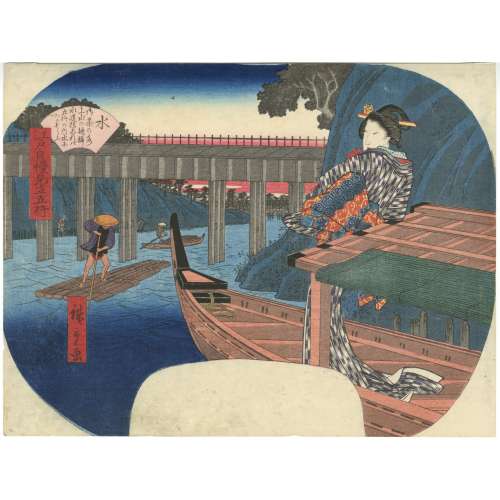 One of five fan prints from the series The Pride of Edo Compared to the Five Elements [Edo jiman mitate gogyo]. Artist: Utagawa Hiroshige [歌川 広重] a.k.a. Andō Hiroshige [安藤 広重] (Japanese, 1797 – 1858). Publisher: Ibaya Kyubei [伊場屋 久兵衛] (Japanese, fl. 1804 – 1851). Signed: Hiroshige ga Censor’s seal: Muramatsu Publisher's seal: Kinseido (Ibaya Kyubei) The text in the fan-shaped cartouche reads: "Water: The Square Aqueduct that Crosses by Suido Bridge Suggests the comparison of Ochanomizu to Water [Mizu: Ochanomizu josui no himasu Suidobashi areba gogyo no uchi mizu ni nazorau]". Ref: Rupert Faulkner. Hiroshige Fan Prints. Victoria and Albert Museum. Far Eastern Series. Hardcover - Harry N. Abrams, Inc. - 2001 [LIB-1344.2017] № 22, p. 51. Comment from Sebastian Izzard: This series of five prints features full-length figures of women set in landscapes around Edo compared to the five natural elements: fire, water, earth, wood, and metal. A preparatory drawing for the “Wood” image, featuring a woman crossing a bridge in the snow at the timber yards of Fukagawa, is owned by the Kanagawa Prefectural Museum of History in Yokohama. A preparatory drawing also exists for the “Earth” image, which portrays a woman seated on a bench at Nakabashi, for which no print is extant. Two examples exist of the “Fire” subject, which pictures a woman holding a lantern at night on an embankment, while in the river behind her fishermen employ fire to trap their catch. The “Water” image depicts a woman on a pleasure boat on the Ocha-no-mizu waterway. One example of the “Metal” subject is known, which was included in Izzard's Important Japanese Prints 1830–1860 March 14–20, 2020 exhibition [LIB-2398.2020], as №. 51.
One of five fan prints from the series The Pride of Edo Compared to the Five Elements [Edo jiman mitate gogyo]. Artist: Utagawa Hiroshige [歌川 広重] a.k.a. Andō Hiroshige [安藤 広重] (Japanese, 1797 – 1858). Publisher: Ibaya Kyubei [伊場屋 久兵衛] (Japanese, fl. 1804 – 1851). Signed: Hiroshige ga Censor’s seal: Muramatsu Publisher's seal: Kinseido (Ibaya Kyubei) The text in the fan-shaped cartouche reads: "Water: The Square Aqueduct that Crosses by Suido Bridge Suggests the comparison of Ochanomizu to Water [Mizu: Ochanomizu josui no himasu Suidobashi areba gogyo no uchi mizu ni nazorau]". Ref: Rupert Faulkner. Hiroshige Fan Prints. Victoria and Albert Museum. Far Eastern Series. Hardcover - Harry N. Abrams, Inc. - 2001 [LIB-1344.2017] № 22, p. 51. Comment from Sebastian Izzard: This series of five prints features full-length figures of women set in landscapes around Edo compared to the five natural elements: fire, water, earth, wood, and metal. A preparatory drawing for the “Wood” image, featuring a woman crossing a bridge in the snow at the timber yards of Fukagawa, is owned by the Kanagawa Prefectural Museum of History in Yokohama. A preparatory drawing also exists for the “Earth” image, which portrays a woman seated on a bench at Nakabashi, for which no print is extant. Two examples exist of the “Fire” subject, which pictures a woman holding a lantern at night on an embankment, while in the river behind her fishermen employ fire to trap their catch. The “Water” image depicts a woman on a pleasure boat on the Ocha-no-mizu waterway. One example of the “Metal” subject is known, which was included in Izzard's Important Japanese Prints 1830–1860 March 14–20, 2020 exhibition [LIB-2398.2020], as №. 51.
Metal. Izzard, 2020.

Fire. Faulkner, 2001.
-
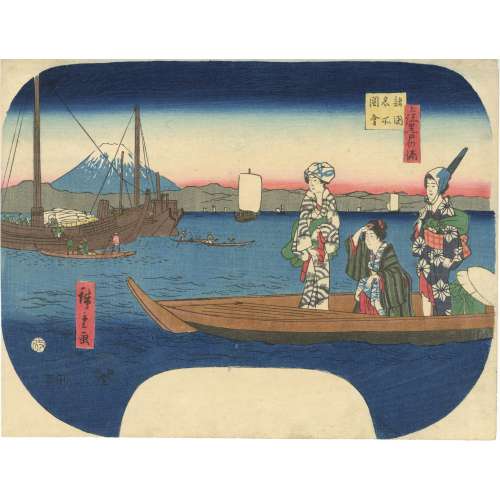 The Bay of Kuroto in Kazusa province [Kazusa Kuroto no ura] – an uncut fan print showing "Three women, wearing stylish cotton summer robes are shown in a skiff, admiring the view of Mount Fuji while looking back at the other passengers being helped into small boats". From the series: Views of famous places in the provinces [Shokoku meisho zue]. Ref: Sebastian Izzard. Important Japanese Prints 1830–1860 March 14–20, 2020 exhibition [LIB-2398.2020], №. 53. Not in Faulkner's Hiroshige Fan Prints, however, there are three other prints from the series, under № 95, 96 and 97 on p. 95. Artist: Utagawa Hiroshige [歌川 広重] a.k.a. Andō Hiroshige [安藤 広重] (Japanese, 1797 – 1858). Publisher: Iseya Sōemon [伊勢屋惣右衛門] (Japanese, c. 1776 – 1862). Date seal: 2/1855 Signed: Hiroshige ga. Censor's seal: aratame (certified) and date. Publisher's seal: Iseya Sōemon. Size: Aiban yoko-e uchiwa-e; 22.9 x 29.8 cm
The Bay of Kuroto in Kazusa province [Kazusa Kuroto no ura] – an uncut fan print showing "Three women, wearing stylish cotton summer robes are shown in a skiff, admiring the view of Mount Fuji while looking back at the other passengers being helped into small boats". From the series: Views of famous places in the provinces [Shokoku meisho zue]. Ref: Sebastian Izzard. Important Japanese Prints 1830–1860 March 14–20, 2020 exhibition [LIB-2398.2020], №. 53. Not in Faulkner's Hiroshige Fan Prints, however, there are three other prints from the series, under № 95, 96 and 97 on p. 95. Artist: Utagawa Hiroshige [歌川 広重] a.k.a. Andō Hiroshige [安藤 広重] (Japanese, 1797 – 1858). Publisher: Iseya Sōemon [伊勢屋惣右衛門] (Japanese, c. 1776 – 1862). Date seal: 2/1855 Signed: Hiroshige ga. Censor's seal: aratame (certified) and date. Publisher's seal: Iseya Sōemon. Size: Aiban yoko-e uchiwa-e; 22.9 x 29.8 cm -
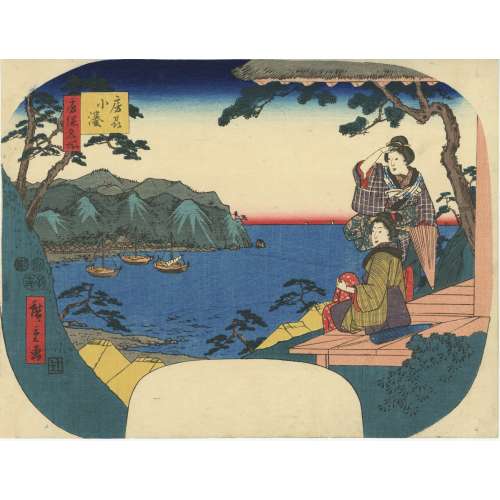 Kominato in Awa province [Awa Kominato] – one of five fan prints in the series Famous places in the Bōsō peninsula [Bōsō meisho], devoted to the trip undertaken by Hiroshige in 1852 to Bōsō peninsula (present-day Chiba prefecture). “Two fashionably dressed women beside the veranda of a wayside inn gaze out over Uchiura Bay toward the Tanjō Temple on the far shore, as a boat sets out to the sea from the fishing hamlet of Kominato. …Hiroshige’s viewpoint is from the lower slopes of Mount Kiyosumi”. Ref: Sebastian Izzard. Important Japanese Prints 1830–1860 March 14–20, 2020 exhibition [LIB-2398.2020], №. 52. Not in Faulkner's Hiroshige Fan Prints. Artist: Utagawa Hiroshige [歌川 広重] a.k.a. Andō Hiroshige [安藤 広重] (Japanese, 1797 – 1858). Publisher: Tsujiya Yasubei [辻屋安兵衛] Kinkaido [錦魁堂] (Japanese, c. 1842 – 1863) Date seal and double nanushi censor seal: Mera & Watanabe; Kaei 5, 11th month (1852). Signed: Hiroshige ga [広重 画] in a red cartouche. Size: Fan print (Aiban yoko-e uchiwa-e); 225 x 292 mm.
Kominato in Awa province [Awa Kominato] – one of five fan prints in the series Famous places in the Bōsō peninsula [Bōsō meisho], devoted to the trip undertaken by Hiroshige in 1852 to Bōsō peninsula (present-day Chiba prefecture). “Two fashionably dressed women beside the veranda of a wayside inn gaze out over Uchiura Bay toward the Tanjō Temple on the far shore, as a boat sets out to the sea from the fishing hamlet of Kominato. …Hiroshige’s viewpoint is from the lower slopes of Mount Kiyosumi”. Ref: Sebastian Izzard. Important Japanese Prints 1830–1860 March 14–20, 2020 exhibition [LIB-2398.2020], №. 52. Not in Faulkner's Hiroshige Fan Prints. Artist: Utagawa Hiroshige [歌川 広重] a.k.a. Andō Hiroshige [安藤 広重] (Japanese, 1797 – 1858). Publisher: Tsujiya Yasubei [辻屋安兵衛] Kinkaido [錦魁堂] (Japanese, c. 1842 – 1863) Date seal and double nanushi censor seal: Mera & Watanabe; Kaei 5, 11th month (1852). Signed: Hiroshige ga [広重 画] in a red cartouche. Size: Fan print (Aiban yoko-e uchiwa-e); 225 x 292 mm. -
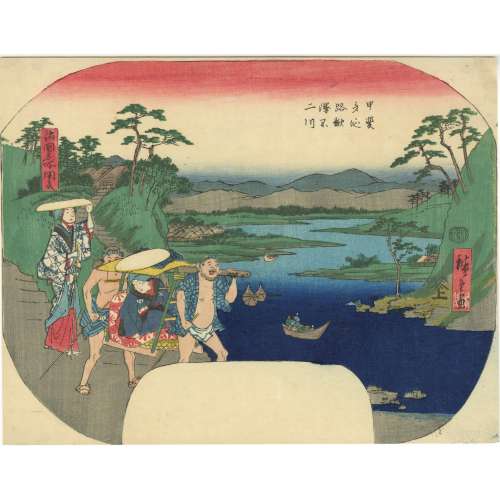 Artist: Utagawa Hiroshige II (二代目 歌川広重] (Japanese, 1826 – 1869). Signed: Hiroshige ga. Publisher: Iseya Sōemon [伊勢屋惣右衛門] (Japanese, c. 1776 – 1862); seal: Hanmoto, Ue [板元 上] (Marks 19-047 | 156d). Combined date seal and kiwame censor seal: Bunkyū 2 (1862) Media: Fan print (uchiwa-e, 団扇絵), 230 x 296 mm.
Artist: Utagawa Hiroshige II (二代目 歌川広重] (Japanese, 1826 – 1869). Signed: Hiroshige ga. Publisher: Iseya Sōemon [伊勢屋惣右衛門] (Japanese, c. 1776 – 1862); seal: Hanmoto, Ue [板元 上] (Marks 19-047 | 156d). Combined date seal and kiwame censor seal: Bunkyū 2 (1862) Media: Fan print (uchiwa-e, 団扇絵), 230 x 296 mm. -
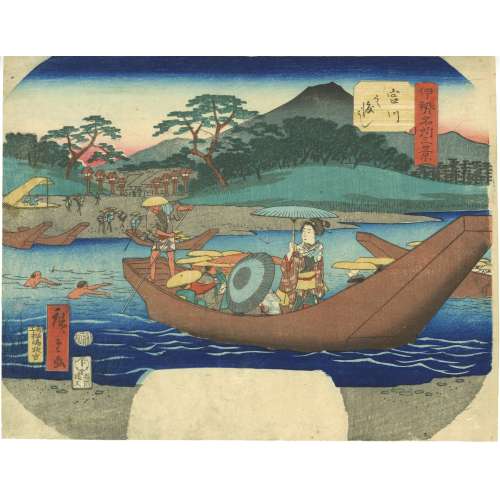 Artist: Utagawa Hiroshige II (二代目 歌川広重] (Japanese, 1826 – 1869). Signed: Hiroshige ga. Publisher: Enshūya Matabei [遠州屋又兵衛] (Japanese, fl. c. 1768 – 1881); (Enmata [遠又]), seal 22-009 (Marks). Block carver: Matsushima Masakichi (Japanese, fl. c. 1847-65); seal: [松嶋彫政] – Hori Masa (Frieze, 2009: 142). Combined date seal and kiwame censor seal: Bunkyū 2 (1862). Media: Fan print (uchiwa-e, 団扇絵), 230 x 298 mm Series: Three Famous Views in Ise [伊勢名所三景] (Ise meisho sankei).
Artist: Utagawa Hiroshige II (二代目 歌川広重] (Japanese, 1826 – 1869). Signed: Hiroshige ga. Publisher: Enshūya Matabei [遠州屋又兵衛] (Japanese, fl. c. 1768 – 1881); (Enmata [遠又]), seal 22-009 (Marks). Block carver: Matsushima Masakichi (Japanese, fl. c. 1847-65); seal: [松嶋彫政] – Hori Masa (Frieze, 2009: 142). Combined date seal and kiwame censor seal: Bunkyū 2 (1862). Media: Fan print (uchiwa-e, 団扇絵), 230 x 298 mm Series: Three Famous Views in Ise [伊勢名所三景] (Ise meisho sankei). -
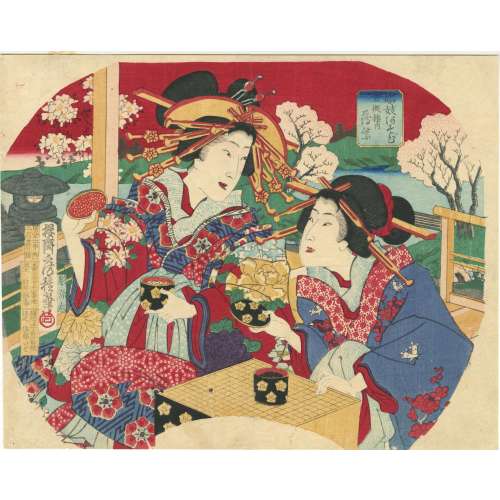 Artist: Utagawa Fusatane [歌川 房種] (Japanese, fl. 1854 – 1889), other names: Ippyosai; Isshosai; Murai Seima; Utagawa Seimas; Osai; Signed: Ōsai Fusatane Hitsu [桜斎房種筆] in a cartouche, with a round stamp. Block carver: Watanabe Yatarō (Japanese, 1850 – 1913); seal [彫弥太] – Hori Yata (Friese 2009b: 117). Publisher [板元] (Hammoto): Satō Ise [佐藤いせ], address: Horiechō, Nichōme, ichi-banchi [堀江町二丁目一番地] Publication date [御届] (otodoke): Meiji 10th year, 3rd month, 22nd day (1877). Artist [画工] (Gakō): Murai Seima [村井 静馬], address: Honjo-Sotodechō, 18 [本所外手丁十八番地]. Uncut fan print (uchiwa-e), 236 x 297 mm, depicting two harlots or courtesans playing [娼妓あそび] (shōgi asobi) go game in the famous Kinpeiro [金瓶楼内] brothel in New Yoshiwara in Tokyo. In the courtesan's name, the second character seems to be 紫 (Murasaki); the first character is unclear, so we do not know her name yet.
Artist: Utagawa Fusatane [歌川 房種] (Japanese, fl. 1854 – 1889), other names: Ippyosai; Isshosai; Murai Seima; Utagawa Seimas; Osai; Signed: Ōsai Fusatane Hitsu [桜斎房種筆] in a cartouche, with a round stamp. Block carver: Watanabe Yatarō (Japanese, 1850 – 1913); seal [彫弥太] – Hori Yata (Friese 2009b: 117). Publisher [板元] (Hammoto): Satō Ise [佐藤いせ], address: Horiechō, Nichōme, ichi-banchi [堀江町二丁目一番地] Publication date [御届] (otodoke): Meiji 10th year, 3rd month, 22nd day (1877). Artist [画工] (Gakō): Murai Seima [村井 静馬], address: Honjo-Sotodechō, 18 [本所外手丁十八番地]. Uncut fan print (uchiwa-e), 236 x 297 mm, depicting two harlots or courtesans playing [娼妓あそび] (shōgi asobi) go game in the famous Kinpeiro [金瓶楼内] brothel in New Yoshiwara in Tokyo. In the courtesan's name, the second character seems to be 紫 (Murasaki); the first character is unclear, so we do not know her name yet. -
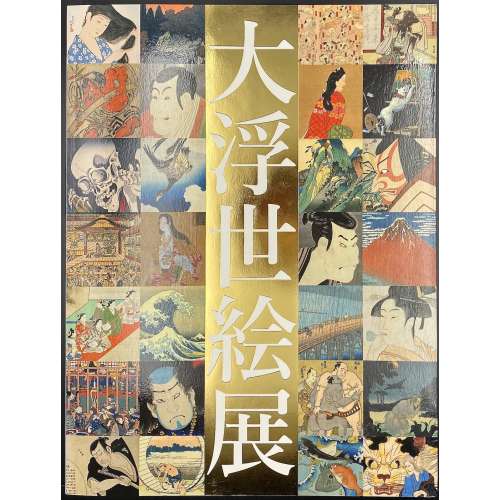 Softcover volume 29.8 x 22.7 cm in publisher’s flapped pictorial wrappers, lettered in Japanese; pp.: [1-4] 5-365 [3], total 184 leaves; pp. 26-267 present 438 illustrations, text in Japanese and English. Reference in this collection: SVJP-0234.2018 – here it is also described as a diptych.
Softcover volume 29.8 x 22.7 cm in publisher’s flapped pictorial wrappers, lettered in Japanese; pp.: [1-4] 5-365 [3], total 184 leaves; pp. 26-267 present 438 illustrations, text in Japanese and English. Reference in this collection: SVJP-0234.2018 – here it is also described as a diptych.
№ 358, p. 226. Bandō Mitsugorō III as Grand arbiter Kiyosumi and Arashi Koroku IV as Koganosuke.
-
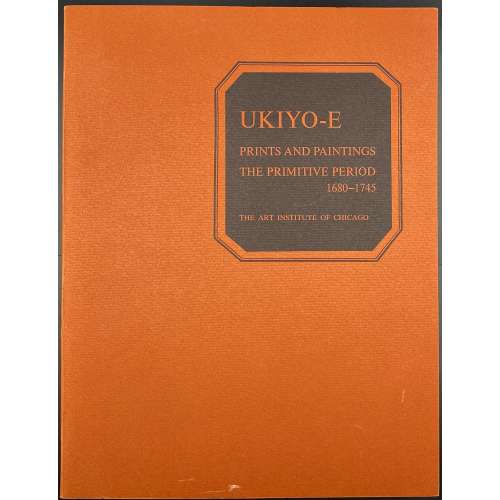 Description: exhibition catalogue, softcover terra-cotta paper with lettered black label to front and black lettering to spine, black endpapers; pp.: [1-6] 7-131 [132] plus colour frontispiece and 5 colour plates outside pagination, 190 entries with b/w in-text illustrations. Front cover (in the octagonal black label): UKIYO-E | PRINTS AND PAINTINGS | THE PRIMITIVE PERIOD | 1680–1745 | THE ART INSTITUTE OF CHICAGO || Title-page: THE ART INSTITUTE OF CHICAGO | UKIYO-E PRINTS AND PAINTINGS | THE PRIMITIVE PERIOD, 1680–1745 | An Exhibition in Memory of Margaret O. Gentles | November 6th–December 26th, 1971 | Catalogue by DONALD JENKINS || Foreword by Charles C. Cunningham, Tribute to Margaret O. Gentles by Jack V. Sewell. Contributors: Margaret O. Gentles (American, 1905 – 1969) Donald John Jenkins (American, b. 1931) Charles Crehore Cunningham (American, 1910 – 1979) Jack V. Sewell (American, 1923 – 2010)
Description: exhibition catalogue, softcover terra-cotta paper with lettered black label to front and black lettering to spine, black endpapers; pp.: [1-6] 7-131 [132] plus colour frontispiece and 5 colour plates outside pagination, 190 entries with b/w in-text illustrations. Front cover (in the octagonal black label): UKIYO-E | PRINTS AND PAINTINGS | THE PRIMITIVE PERIOD | 1680–1745 | THE ART INSTITUTE OF CHICAGO || Title-page: THE ART INSTITUTE OF CHICAGO | UKIYO-E PRINTS AND PAINTINGS | THE PRIMITIVE PERIOD, 1680–1745 | An Exhibition in Memory of Margaret O. Gentles | November 6th–December 26th, 1971 | Catalogue by DONALD JENKINS || Foreword by Charles C. Cunningham, Tribute to Margaret O. Gentles by Jack V. Sewell. Contributors: Margaret O. Gentles (American, 1905 – 1969) Donald John Jenkins (American, b. 1931) Charles Crehore Cunningham (American, 1910 – 1979) Jack V. Sewell (American, 1923 – 2010) -
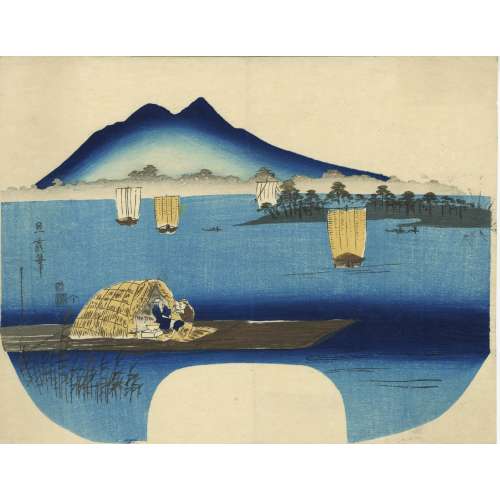 Artist: Tsukioka Tanka [旦霞] (Japanese, fl. c. 1830s – 1840s). Publisher: Enshūya Matabei [遠州屋又兵衛] (Japanese, fl. c. 1768 – 1881); seal: Enmata. Title: Picture of Fuji, Tsukuba and Sumida River [富士筑波隅田川の圖] (フジ ツクバ スミダガワ ノ ズ | Fuji Tsukuba Sumidagawa no zu). Date seal 巳 + kiwame: Tenpō 4 (1833). Media: Fan print (uchiwa-e, 団扇絵), 235 x 302 mm, aizuri-e. Only four prints are known from this artist, all fans: (1) National Diet Library 2542868:
Artist: Tsukioka Tanka [旦霞] (Japanese, fl. c. 1830s – 1840s). Publisher: Enshūya Matabei [遠州屋又兵衛] (Japanese, fl. c. 1768 – 1881); seal: Enmata. Title: Picture of Fuji, Tsukuba and Sumida River [富士筑波隅田川の圖] (フジ ツクバ スミダガワ ノ ズ | Fuji Tsukuba Sumidagawa no zu). Date seal 巳 + kiwame: Tenpō 4 (1833). Media: Fan print (uchiwa-e, 団扇絵), 235 x 302 mm, aizuri-e. Only four prints are known from this artist, all fans: (1) National Diet Library 2542868:
(2) Ritsumeikan University mai30_07:

 (3) RISD Museum 34.334:
(3) RISD Museum 34.334:

-
 Iron tsuba of the round form (丸型, maru–gata), decorated with brass flat inlay (平象嵌, hira-zōgan) of bellflowers, leaves, and vines on both sides, inlaid brass is carved in low relief; wide rim (dote-mimi) also inlaid; the plate is pierced with hitsu-ana (probably original); nakago-ana plugged with copper sekigane. Dimensions: Height: 84.1 mm; Width: 82.0 mm; Thickness (centre): 2.8 mm; mimi is 11.8 mm wide and 4.7 mm thick. Produced at the end of the 16th century, in the Momoyama period (1674–1703).
Iron tsuba of the round form (丸型, maru–gata), decorated with brass flat inlay (平象嵌, hira-zōgan) of bellflowers, leaves, and vines on both sides, inlaid brass is carved in low relief; wide rim (dote-mimi) also inlaid; the plate is pierced with hitsu-ana (probably original); nakago-ana plugged with copper sekigane. Dimensions: Height: 84.1 mm; Width: 82.0 mm; Thickness (centre): 2.8 mm; mimi is 11.8 mm wide and 4.7 mm thick. Produced at the end of the 16th century, in the Momoyama period (1674–1703). -
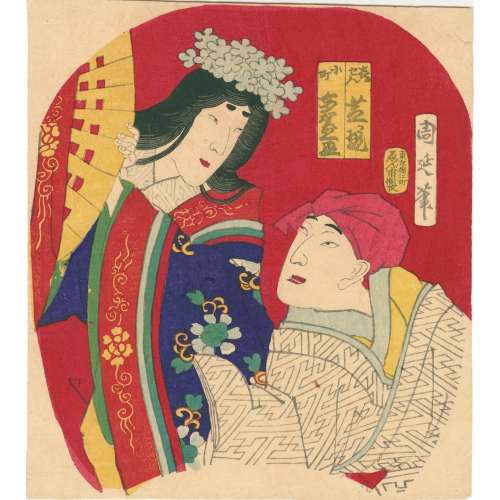 Artist: Toyohara Chikanobu [豊原周延] (Japanese, 1838 – 1912) Signed: Chikanobu hitsu [周延筆] Publisher: [ 東京掘江町] Tokyo Horiemachi | [えん市製] Enshi-sei. Media: Fan print (uchiwa-e, 団扇絵), 192 x 172 mm. Possibly Iwai Kumesaburō IV [岩井粂三郎] (1856 – 1886) a.k.a. Iwai Hisajirō III [岩井久次郎] in the role of Ono no Komachi [小野乃小町] and Nakamura Shikan IV [中村芝翫] in the role of Kisen Hōshi [喜せん法師]. Play: The Six Immortal Poets in Colorful Guises [六歌仙体綵] (Rokkasen Sugata no irodori). Inscription: Left: Kisen [喜せん] | Shikan [芝翫] Right: Komachi [小町] | Kumesaburō [粂三郎]. Actors: Iwai Kumesaburō IV [岩井粂三郎] (1856 – 1886) a.k.a. Iwai Hisajirō III [岩井久次郎]. Nakamura Shikan IV [中村芝翫] (Japanese, 1831 – 1899); other names: Nakamura Fukusuke I [中村福助], Nakamura Masanosuke I, Nakamura Komasaburō, Nakamura Tamatarō I.
Artist: Toyohara Chikanobu [豊原周延] (Japanese, 1838 – 1912) Signed: Chikanobu hitsu [周延筆] Publisher: [ 東京掘江町] Tokyo Horiemachi | [えん市製] Enshi-sei. Media: Fan print (uchiwa-e, 団扇絵), 192 x 172 mm. Possibly Iwai Kumesaburō IV [岩井粂三郎] (1856 – 1886) a.k.a. Iwai Hisajirō III [岩井久次郎] in the role of Ono no Komachi [小野乃小町] and Nakamura Shikan IV [中村芝翫] in the role of Kisen Hōshi [喜せん法師]. Play: The Six Immortal Poets in Colorful Guises [六歌仙体綵] (Rokkasen Sugata no irodori). Inscription: Left: Kisen [喜せん] | Shikan [芝翫] Right: Komachi [小町] | Kumesaburō [粂三郎]. Actors: Iwai Kumesaburō IV [岩井粂三郎] (1856 – 1886) a.k.a. Iwai Hisajirō III [岩井久次郎]. Nakamura Shikan IV [中村芝翫] (Japanese, 1831 – 1899); other names: Nakamura Fukusuke I [中村福助], Nakamura Masanosuke I, Nakamura Komasaburō, Nakamura Tamatarō I. -
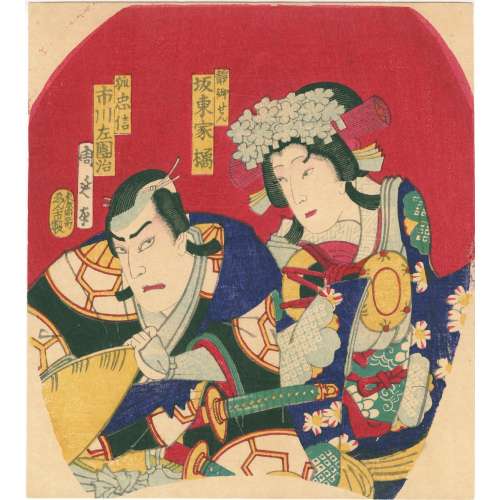 Artist: Toyohara Chikanobu [豊原周延] (Japanese, 1838 – 1912) Signed: Chikanobu ga [周延画] Publisher: [ 東京掘江町] Tokyo Horiemachi | [えん市製] Enshi-sei. Media: Fan print (uchiwa-e, 団扇絵), 192 x 172 mm. Actors: Female: Bandō Kakitsu I in the role of Shizuka Gozen [静御前]. Male: Ichikawa Sadanji I in the role of Kitsune Tadanobu [狐忠信], a.k.a. Satō Tadanobu [佐藤 忠信]. Bandō Kakitsu I [初代 坂東 家橘] (Japanese, 1847 – 1893); other names: Ichimura Kakitsu V, Ichimura Uzaemon XIV, Ichimura Kakitsu V, Ichimura Uzaemon XIV, Ichimura Takematsu III. Ichikawa Sadanji I [市川左団次] (Japanese, 1842 – 1904); other names: Ichikawa Shōjaku I, Ichikawa Koyone, Ichikawa Tatsuzō.
Artist: Toyohara Chikanobu [豊原周延] (Japanese, 1838 – 1912) Signed: Chikanobu ga [周延画] Publisher: [ 東京掘江町] Tokyo Horiemachi | [えん市製] Enshi-sei. Media: Fan print (uchiwa-e, 団扇絵), 192 x 172 mm. Actors: Female: Bandō Kakitsu I in the role of Shizuka Gozen [静御前]. Male: Ichikawa Sadanji I in the role of Kitsune Tadanobu [狐忠信], a.k.a. Satō Tadanobu [佐藤 忠信]. Bandō Kakitsu I [初代 坂東 家橘] (Japanese, 1847 – 1893); other names: Ichimura Kakitsu V, Ichimura Uzaemon XIV, Ichimura Kakitsu V, Ichimura Uzaemon XIV, Ichimura Takematsu III. Ichikawa Sadanji I [市川左団次] (Japanese, 1842 – 1904); other names: Ichikawa Shōjaku I, Ichikawa Koyone, Ichikawa Tatsuzō. -
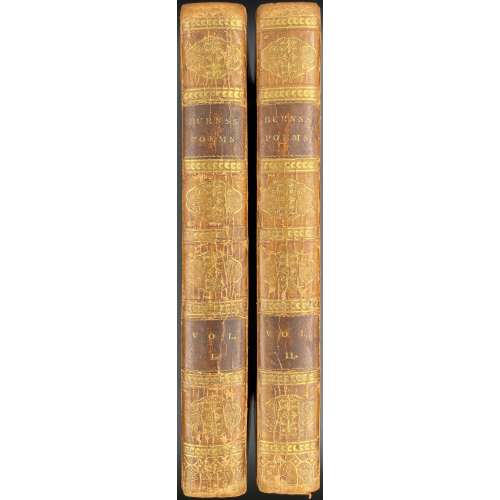 Description: Two volumes, collated 4to, usually described as 12mo, 16.5 x 10.5 cm each, uniformly bound in full calf, bordered in gilt with a triple-fillet over blind dentelle, flat spine ornamented in gilt with two crimson labels, gilt dentelle inside, blue marbled endpapers with previous owner bookplate to front pastedown in each vol.: "W. E. A. MACDONNELL. | NEW HALL | Co. of Clare.", and a ticket in a blue border “162”. Illustrated by T. Bewick after J. Thurston with frontispiece portrait of Robert Burns, numerous woodcut endpieces and a total of 14 full-page woodcut vignettes throughout. Title-page: THE | POETICAL WORKS | OF | ROBERT BURNS; | WITH HIS LIFE | ORNAMENTED WITH | ENGRAVINGS ON WOOD BY MR. BEWICK | FROM ORIGINAL DESIGNS BY MR. THURSTON. | — | IN TWO VOLUMES. | VOL I. (VOL. II.) | — | ALNWICK: | Printed by William Davison. | SOLD BY THE BOOKSELLERS IN ENGLAND, SCOTLAND | AND IRELAND. | – | 1808. || Vol. 1: Collation: π3 (1st blank, engraved frontispiece portrait of R. Burns, t.p.), a2 b-e4, A-Z4, 2A-2E4 (2E)4 (last two blank); total 137 leaves, numerous endpieces and 9 woodcut plates by Thomas Bewick after John Thurston within collation. Pagination: [2 blank] [i-v] 6 (i.e. vi) xlii [43-45] 46-268 (265-268 marked 263–266, respectively, [4 blank]; total 274 pages, of which 6 blank (pagination by Hugo: xlii, 297, 26), full-page plates opposite to pp. 73, 82, 106, 127, 141, 178, 192, 213, 219. Vol. 2: Collation: π5 (1st blank, t.p., 3 leaves of contents), A-B4 (C omitted) D-Z4, 2A-2G4 (2H omitted) 2I2 2K-2M4 2N1 χ2; total 138 leaves, numerous endpieces and 6 woodcut plates by Thomas Bewick after John Thurston within collation. Pagination: [2 blank] [i-iii] iv-xi (v marked vii, viii marked ix), 12-270 (16 marked 17, 76 marked 67, 84 marked 86, 96 marked 90, 112 marked 110, 203-207 marked 205-209, 220-224 marked 222-226), [4 blank]; total 276 pages, of which 6 blank (pagination by Hugo: xii, 320), full-page plates opposite to pp. 11, 40, 70, 191, 221. Catalogue raisonné: Hugo (1866): № 230, v. 1, p. 92-93; according to Hugo, the year 1808 was not stated, the number of pages in each volume is different to my copy. Provenance: Colonel William Edward Armstrong-Macdonnell (Irish, 1858 – 1883) of New Hall, Ennis, County Clare, Ireland (presumed). Contributors: Robert Burns (Scottish, 1759 – 1796) – author. Thomas Bewick (British, 1753 – 1828) – engraver. John Thurston (British, 1774 – 1822) – artist. William Davison (British, 1781 – 1858) – printer/publisher.
Description: Two volumes, collated 4to, usually described as 12mo, 16.5 x 10.5 cm each, uniformly bound in full calf, bordered in gilt with a triple-fillet over blind dentelle, flat spine ornamented in gilt with two crimson labels, gilt dentelle inside, blue marbled endpapers with previous owner bookplate to front pastedown in each vol.: "W. E. A. MACDONNELL. | NEW HALL | Co. of Clare.", and a ticket in a blue border “162”. Illustrated by T. Bewick after J. Thurston with frontispiece portrait of Robert Burns, numerous woodcut endpieces and a total of 14 full-page woodcut vignettes throughout. Title-page: THE | POETICAL WORKS | OF | ROBERT BURNS; | WITH HIS LIFE | ORNAMENTED WITH | ENGRAVINGS ON WOOD BY MR. BEWICK | FROM ORIGINAL DESIGNS BY MR. THURSTON. | — | IN TWO VOLUMES. | VOL I. (VOL. II.) | — | ALNWICK: | Printed by William Davison. | SOLD BY THE BOOKSELLERS IN ENGLAND, SCOTLAND | AND IRELAND. | – | 1808. || Vol. 1: Collation: π3 (1st blank, engraved frontispiece portrait of R. Burns, t.p.), a2 b-e4, A-Z4, 2A-2E4 (2E)4 (last two blank); total 137 leaves, numerous endpieces and 9 woodcut plates by Thomas Bewick after John Thurston within collation. Pagination: [2 blank] [i-v] 6 (i.e. vi) xlii [43-45] 46-268 (265-268 marked 263–266, respectively, [4 blank]; total 274 pages, of which 6 blank (pagination by Hugo: xlii, 297, 26), full-page plates opposite to pp. 73, 82, 106, 127, 141, 178, 192, 213, 219. Vol. 2: Collation: π5 (1st blank, t.p., 3 leaves of contents), A-B4 (C omitted) D-Z4, 2A-2G4 (2H omitted) 2I2 2K-2M4 2N1 χ2; total 138 leaves, numerous endpieces and 6 woodcut plates by Thomas Bewick after John Thurston within collation. Pagination: [2 blank] [i-iii] iv-xi (v marked vii, viii marked ix), 12-270 (16 marked 17, 76 marked 67, 84 marked 86, 96 marked 90, 112 marked 110, 203-207 marked 205-209, 220-224 marked 222-226), [4 blank]; total 276 pages, of which 6 blank (pagination by Hugo: xii, 320), full-page plates opposite to pp. 11, 40, 70, 191, 221. Catalogue raisonné: Hugo (1866): № 230, v. 1, p. 92-93; according to Hugo, the year 1808 was not stated, the number of pages in each volume is different to my copy. Provenance: Colonel William Edward Armstrong-Macdonnell (Irish, 1858 – 1883) of New Hall, Ennis, County Clare, Ireland (presumed). Contributors: Robert Burns (Scottish, 1759 – 1796) – author. Thomas Bewick (British, 1753 – 1828) – engraver. John Thurston (British, 1774 – 1822) – artist. William Davison (British, 1781 – 1858) – printer/publisher. -
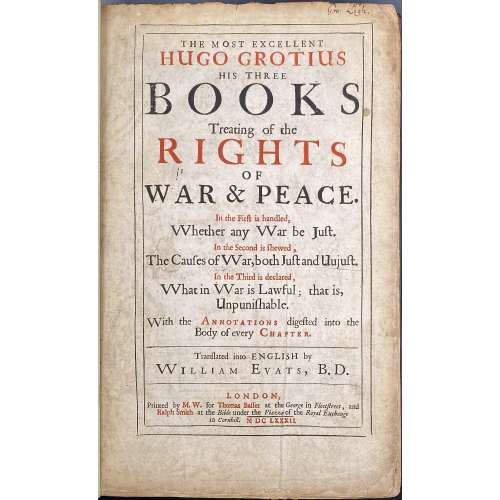 Volume collated 4to, 32.5 x 21 cm, later full calf, blind-tooled boards, sunned, raised bands and gilt lettering to spine. bound without the additional engraved title-page sometimes present; title printed in black and red, woodcut headpieces and initials; a little foxing (mostly marginal) throughout, title lightly dust stained with slight chipping at extremities, minor marginal worming to early leaves (b3-I4), paper flaw to outer margin of E1; contemporary English ownership inscription of George Legh to the title, a handful of manuscript corrections to text and annotations to index. Title-page (double frame, red and black, tall ‘s’): THE MOST EXCELLENT | HUGO GROTIUS | HIS THREE | BOOKS | Treating of the | RIGHTS | OF | WAR & PEACE. | In the First is handled, | Whether any War be Just. | In the Second is shewed , | The Causes of War, both Just and Uujust (sic). | In the Third is declared , | What in War is Lawful ; that is, | Unpunishable. | With the Annotations digested into the | Body of every Chapter. | — | Translated into ENGLISH by | William Evats, B. D. | — | LONDON, | Printed by M. W. for Thomas Basset at the George in Fleetstreet, and | Ralph Smith at the Bible under the Piazza of the Royal Exchange | in Cornhill. M DC LXXXII. || Collation: A4 a-b4 c3 B-Z4 2A-2D4 2E6 3A-3Z4 4A-4D4 4E-4L2; total 247 leaves as called for; lacking engraved title-page. Pagination: [4] i-xxi [5] 1-220 (text continuous) 361-572 [573] [574 blank] [30 table]; total 494 pages. Seller’s note: First edition of the first complete English translation, following Barksdale’s abridgement, of Grotius’s landmark work of political philosophy, the first treatise on international law. First published in Latin in 1625, Grotius’s De iure belli ac pacis “became the basic manual for both the theoretical justification and the entire practice of the international law of war as well as of international law in general for the whole period of the ancien régime in Europe” [Duchhardt, p. 288]. “It would be hard to imagine any work more central to the intellectual world of the Enlightenment … [By] the time of the post-First World War settlement, Grotius was regarded almost exclusively as the founder of modern civilized interstate relations, and as a suitable tutelary presence for the new Peace Palace at The Hague … [In] some ways that was to radically misunderstand Grotius’s views on war; he was in fact much more of an apologist for aggression and violence than many of his more genuinely innovative qualities of his moral theory, qualities that entitle him to an essential place in the history of political theory …” [Tuck, pp. xi-xii]. Contributors: Hugo Grotius (Dutch, 1583 – 1645) – author. William Evats (British, c.1606 – 1677) – translator. Margaret White (British, fl. 1678 – 1683) – printer. Thomas Bassett (British, fl. c. 1659 – 1693) – publisher/bookseller. Ralph Smith (British, fl. 1642 – 1684) – publisher/bookseller.
Volume collated 4to, 32.5 x 21 cm, later full calf, blind-tooled boards, sunned, raised bands and gilt lettering to spine. bound without the additional engraved title-page sometimes present; title printed in black and red, woodcut headpieces and initials; a little foxing (mostly marginal) throughout, title lightly dust stained with slight chipping at extremities, minor marginal worming to early leaves (b3-I4), paper flaw to outer margin of E1; contemporary English ownership inscription of George Legh to the title, a handful of manuscript corrections to text and annotations to index. Title-page (double frame, red and black, tall ‘s’): THE MOST EXCELLENT | HUGO GROTIUS | HIS THREE | BOOKS | Treating of the | RIGHTS | OF | WAR & PEACE. | In the First is handled, | Whether any War be Just. | In the Second is shewed , | The Causes of War, both Just and Uujust (sic). | In the Third is declared , | What in War is Lawful ; that is, | Unpunishable. | With the Annotations digested into the | Body of every Chapter. | — | Translated into ENGLISH by | William Evats, B. D. | — | LONDON, | Printed by M. W. for Thomas Basset at the George in Fleetstreet, and | Ralph Smith at the Bible under the Piazza of the Royal Exchange | in Cornhill. M DC LXXXII. || Collation: A4 a-b4 c3 B-Z4 2A-2D4 2E6 3A-3Z4 4A-4D4 4E-4L2; total 247 leaves as called for; lacking engraved title-page. Pagination: [4] i-xxi [5] 1-220 (text continuous) 361-572 [573] [574 blank] [30 table]; total 494 pages. Seller’s note: First edition of the first complete English translation, following Barksdale’s abridgement, of Grotius’s landmark work of political philosophy, the first treatise on international law. First published in Latin in 1625, Grotius’s De iure belli ac pacis “became the basic manual for both the theoretical justification and the entire practice of the international law of war as well as of international law in general for the whole period of the ancien régime in Europe” [Duchhardt, p. 288]. “It would be hard to imagine any work more central to the intellectual world of the Enlightenment … [By] the time of the post-First World War settlement, Grotius was regarded almost exclusively as the founder of modern civilized interstate relations, and as a suitable tutelary presence for the new Peace Palace at The Hague … [In] some ways that was to radically misunderstand Grotius’s views on war; he was in fact much more of an apologist for aggression and violence than many of his more genuinely innovative qualities of his moral theory, qualities that entitle him to an essential place in the history of political theory …” [Tuck, pp. xi-xii]. Contributors: Hugo Grotius (Dutch, 1583 – 1645) – author. William Evats (British, c.1606 – 1677) – translator. Margaret White (British, fl. 1678 – 1683) – printer. Thomas Bassett (British, fl. c. 1659 – 1693) – publisher/bookseller. Ralph Smith (British, fl. 1642 – 1684) – publisher/bookseller. -
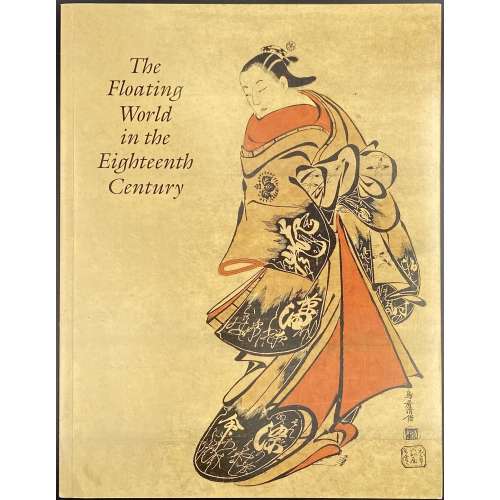 Softcover, in pictorial wrappers, 28 x 21.7 cm, 25 entries, with colour illustrations, some folding. Catalogue of the sales exhibition on March 28 -April 7, 2006, in NY; pagination: [2] 3-61 [62 blank [2], ils. Contributor: Sebastian Izzard
Softcover, in pictorial wrappers, 28 x 21.7 cm, 25 entries, with colour illustrations, some folding. Catalogue of the sales exhibition on March 28 -April 7, 2006, in NY; pagination: [2] 3-61 [62 blank [2], ils. Contributor: Sebastian Izzard -
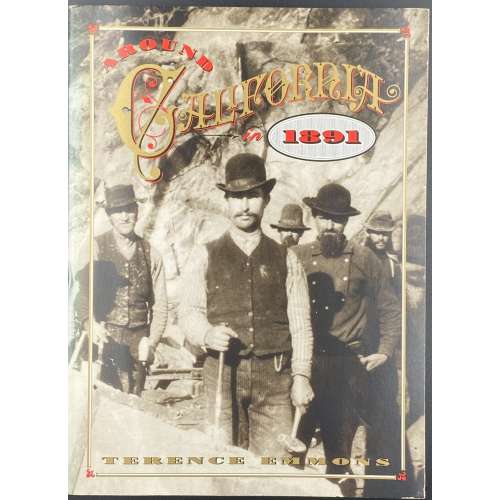 Softcover, 22.5 x 16.5 cm, pictorial paperback, pp.: [i-xi] xii-xix [xx blank] [2] [1] 2-179 [180] [6 advert.], total 206 pp plus cardstock Portable Stanford form. Nicholas Russel [Николай Константинович Судзиловский] (Russian-American, 1850 – 1930)
Softcover, 22.5 x 16.5 cm, pictorial paperback, pp.: [i-xi] xii-xix [xx blank] [2] [1] 2-179 [180] [6 advert.], total 206 pp plus cardstock Portable Stanford form. Nicholas Russel [Николай Константинович Судзиловский] (Russian-American, 1850 – 1930) -
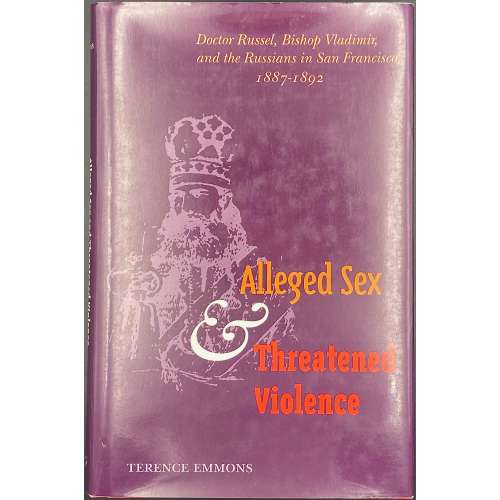 Hardcover volume, 22.5 x 15 cm, bound in red cloth with gilt lettering to spine, pictorial dust jacket; pp.: [i-v] vi-xiv, [1-5] 6-251 [252], total 268 pages. Title-page: Alleged sex and threatened violence | Doctor Russel, Bishop Vladimir, and the Russians in | San Francisco, 1887-1892 | TERENCE EMMONS | — | Stanford University Press | Stanford, California | 1977 || ISBN: 9780804727679, 9780804727686, 0804727678, 0804727686. OCLC Number / Unique Identifier: 35159156. Doctor Nikolai Sudzilovsky [Nicholas Russel] (Belarusian, 1850 – 1930). Bishop Vladimir (Sokolovsky-Avtonomov, Vasily Grigorievich) Архиепископ Владимир (Соколовский-Автономов, Василий Григорьевич) (Russian, 1852 – 1931) – Archbishop of the Aleutians and Alaska.
Hardcover volume, 22.5 x 15 cm, bound in red cloth with gilt lettering to spine, pictorial dust jacket; pp.: [i-v] vi-xiv, [1-5] 6-251 [252], total 268 pages. Title-page: Alleged sex and threatened violence | Doctor Russel, Bishop Vladimir, and the Russians in | San Francisco, 1887-1892 | TERENCE EMMONS | — | Stanford University Press | Stanford, California | 1977 || ISBN: 9780804727679, 9780804727686, 0804727678, 0804727686. OCLC Number / Unique Identifier: 35159156. Doctor Nikolai Sudzilovsky [Nicholas Russel] (Belarusian, 1850 – 1930). Bishop Vladimir (Sokolovsky-Avtonomov, Vasily Grigorievich) Архиепископ Владимир (Соколовский-Автономов, Василий Григорьевич) (Russian, 1852 – 1931) – Archbishop of the Aleutians and Alaska.


